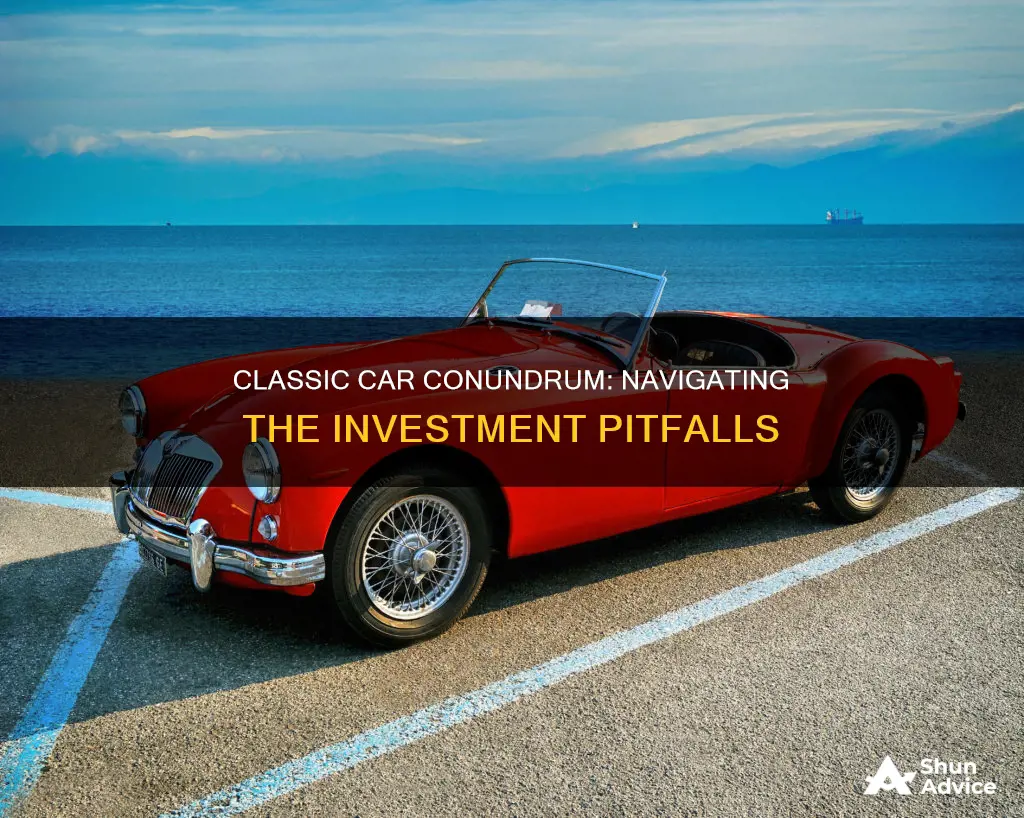
Classic cars are a great investment opportunity, offering the chance to own a piece of automotive history while also providing substantial returns. The market for classic cars is growing year on year, increasing by over 180% in the past decade. Here are some things to consider if you're thinking of investing in a classic car:
- Rarity: Classic cars are a finite asset, and their limited numbers make them highly sought after by collectors and enthusiasts.
- Cultural Significance: Classic cars often have an interesting backstory, associated with iconic moments in history, pop culture, and motorsport, adding to their allure.
- Design and Craftsmanship: The unique design and craftsmanship of classic cars are prized by collectors, with their artistry, engineering, and attention to detail setting them apart from modern cars.
- Performance: Classic cars with powerful engines and impressive performance capabilities tend to be more desirable and sought-after.
- Condition and Maintenance: A classic car that is well-maintained and in good condition will hold its value better and is more likely to appreciate over time.
- Limited Production Runs: Cars that were part of a limited production run or were the first in a new design or generation tend to be more valuable.
- Collectibility: Some classic cars are more desirable to collectors due to their brand, model, or association with a particular event or figure.
- Porsche 911 (1960s): With its distinctive design and high-quality construction, the 1960s Porsche 911 is one of the most iconic and sought-after classic cars.
- Jaguar E-Type (1961): Often referred to as the most beautiful car ever made, the Jaguar E-Type combines sleek design, powerful performance, and premium materials.
- Chevrolet Corvette (1960s): The sleek and sporty Chevrolet Corvette is an iconic American classic car with a racing heritage and a continued presence in popular culture.
- Lamborghini Countach (1970s): This groundbreaking sports car features a radical, wedge-shaped design and a powerful V12 engine, making it a true engineering masterpiece.
- Porsche 930 Turbo (1970s): Introduced in the mid-1970s, the Porsche 930 Turbo is a high-performance sports car known for its sleek, aerodynamic design and turbocharged engine.
- Aston Martin DB5 (1960s): The iconic Aston Martin DB5, famously driven by James Bond, features timeless design, a powerful engine, and a luxurious interior.
- BMW 507 (1957): Loved for its beautiful design and advanced engineering, the BMW 507 is a classic roadster that, despite its commercial failure, has become a valuable investment.
What You'll Learn

Rare luxury vehicles
When it comes to investing in classic cars, it's important to consider rare luxury vehicles that can appreciate in value over time. Here are some insights on this topic:
Factors to Consider:
Before investing in a rare luxury vehicle, it's important to research its history and any major repairs. Determining a budget and the level of restoration work you're willing to undertake are also crucial steps. Additionally, staying informed about current trends in the car market will help you make a wise investment decision.
Popular Choices:
Luxury sports cars like the Lamborghini Countach, Porsche 911 Turbo, and supercars such as the Ferrari LaFerrari or McLaren P1 are highly desirable due to their limited availability and collectability. These vehicles offer a unique driving experience and the potential for greater returns than traditional investments.
Tips for Maximizing Returns:
To maximize returns, it's essential to keep rare luxury vehicles well-maintained and in good condition. Regular maintenance checks and timely repairs are crucial. Additionally, staying informed about market trends and consulting with experts in the field can help you make strategic buying and selling decisions.
Examples of Rare Luxury Vehicles:
Some examples of rare luxury vehicles that have been mentioned as potential investments include the Rolls-Royce Cullinan, Bugatti Chiron, Aston Martin, and vintage models such as the 1934 Packard Twelve 1108 Dietrich, which sold for $1.435 million in 2021.
Nifty: Invest Now or Later?
You may want to see also

Classic muscle cars
Classic cars, especially classic muscle cars, are iconic. They embody the freedom and thrill that all cars should possess. They are works of art, and there is so much passion and character behind them.
Muscle cars are typically defined as high-performance automobiles with powerful V8 engines designed for high-performance driving. They are distinct from two-seat sports cars and expensive GTs intended for high-speed touring and road racing.
- 1968 Ford Shelby Mustang GT500: The first-generation Mustang GT500 is a true force to be reckoned with, even around a track. With its 355 hp 7.0-liter V8 engine and incredible design, it is a piece of history on wheels.
- 1966 Pontiac GTO: With its stylish front end and double headlights, the mid-1960s Pontiac GTO is a classic choice. It packed somewhere around 360 horsepower into a lightweight, engine-focused design.
- 1968 Chevrolet Camaro: The Chevrolet Camaro is one of the few muscle cars that have successfully come back into existence in recent years. It is an icon and one of the true heavyweights of the muscle car world. Special models like the Z28, which turned the Camaro into a racing car, are especially valuable.
- 1969 Dodge Charger R/T: The Dodge Charger is arguably the most iconic American muscle car. With its graceful styling and massive 375 horsepower, it embodies the spirit of muscle cars and the people of its time.
- 1970 Chevrolet Chevelle SS: While not the most iconic name, the Chevrolet Chevelle is a classic muscle car that remains popular today. It is known for its powerful engine and sleek design.
- 1971 Plymouth Road Runner: The Plymouth Road Runner is a true classic and a simple, affordable version of a muscle car. With 335 horsepower and a respectable quarter-mile time, it offers power and performance without sacrificing affordability.
- 1974 Dodge Challenger: The Dodge Challenger was in its glory days during the height of muscle cars. It fed off the excitement and passion of car manufacturers and buyers, resulting in spectacular cars made with genuine care and craftsmanship.
When investing in classic muscle cars, it is important to consider factors such as make, model, condition, mileage, and engine size. Additionally, the cost of restoration or repairs should be factored in to preserve these vehicles for years to come.
Investments: Where People Put Their Money
You may want to see also

Investment-grade exotics
Ford Mustang GT500 or Chevrolet Camaro SS
The Ford Mustang GT500 and the Chevrolet Camaro SS are classic muscle cars known for their powerful engines and sleek designs. These cars have a wide appeal, with collectors and enthusiasts valuing their performance and iconic status.
Lamborghini Countach
The Lamborghini Countach is a groundbreaking 1970s sports car with a radical, wedge-shaped design. It is powered by a V12 engine and can go from 0 to 60 mph in just 5.4 seconds. The Countach's innovative use of materials such as carbon fibre and Kevlar makes it a true engineering masterpiece.
Porsche 930 Turbo
Introduced in the mid-1970s, the Porsche 930 Turbo is one of the most iconic sports cars ever made. With its sleek, aerodynamic design and powerful turbocharged engine, it became known as a high-performance wild powerhouse. The 930 Turbo has a well-deserved reputation for speed and precision, earning it the nickname "Widowmaker".
Aston Martin DB5
The Aston Martin DB5 is an iconic British sports car famously driven by James Bond in the 007 films. Its timeless design, powerful engine, and association with Bond have made it highly desirable among collectors. The DB5 is often considered one of the most beautiful cars ever produced by Aston Martin.
BMW 507
The 1957 BMW 507 is a classic roadster with a beautiful design and advanced engineering. While it was a commercial failure due to its high price tag, it has since become a valuable collector's item. The car is loved for its long hood and short trunk design, and its association with famous owners like Elvis Presley has driven up its popularity.
Ferrari 250 GT
Produced by Ferrari in the 1960s, the 250 GT is known for its sleek design and powerful engine. Its classic styling and racing victories have contributed to its enduring popularity. The limited number of models produced and their rarity today make the 250 GT highly coveted among collectors.
Market Recovery: When Will Investments Rebound?
You may want to see also

Popular collectible cars
Classic cars are a finite asset, making them a great investment opportunity. Their value tends to appreciate over time, and their rarity and cultural significance add to their appeal. Here are some popular collectible cars:
1960s Chevrolet Corvette
The Chevrolet Corvette is an iconic American classic car with a sleek and sporty design. Its fibreglass body and powerful engine made it a popular choice for car enthusiasts. The Corvette's history as a racing car and its continued presence in popular culture have cemented its status as a beloved collectible. Its rarity and timeless design make it highly sought-after, and its value is expected to remain high.
1955 Mercedes-Benz 300SL
The 1955 Mercedes-Benz 300SL is a racing car known for its unique gull-wing doors and sleek, aerodynamic body. With only 1,400 produced, it is a rare find for collectors. Its powerful 3.0-litre engine delivered an impressive 215 horsepower, making it one of the fastest and most desirable cars of its time. The 300SL's rarity, timeless design, and exceptional performance contribute to its high resale value.
1960s Porsche 911
The Porsche 911, produced in the 1960s, is one of the most iconic and sought-after classic cars globally. Its distinctive round headlights, long hood, and sloping roofline make it instantly recognisable. The 911's rarity and the high quality of its construction materials further enhance its value. Investing in a 1960s Porsche 911 is not just a financial decision but also a passion investment, with one selling for a record-breaking price in 2022.
1961 Jaguar E-Type
The Jaguar E-Type, often referred to as "the most beautiful car ever made," is a timeless beauty with sleek lines and graceful curves. Its lightweight aluminium body, powerful engine, and smooth handling made it a favourite among car enthusiasts. The Jaguar E-Type's rich history includes being driven by Prince Philip in the 1960s and appearing in the James Bond film "Die Another Day." Its timeless design, premium materials, and high resale value continue to attract collectors and investors.
1960s Shelby Cobra 427
The Shelby Cobra 427, created in the early 1960s by Carroll Shelby, is a true powerhouse. Shelby fitted a British AC Ace roadster with a powerful Ford V8 engine. The Cobra's sleek lines and aggressive styling have made it a classic, and its lightweight aluminium body was revolutionary at the time. The Cobra's exclusivity, timeless design, and racing heritage have made it highly desirable, with one selling for a record-breaking price in 2016.
1960s Ferrari 250 GT
Produced by Ferrari in the 1960s, the 250 GT is known for its sleek design and powerful engine, making it a popular choice for racing enthusiasts. The car's classic design and racing victories have contributed to its enduring popularity. The limited number of 250 GT models produced adds to their rarity and high market value. Investing in a 1960s Ferrari 250 GT is a wise choice, as its value is expected to continue appreciating over time. However, the cost of maintenance, storage, and insurance can be substantial.
Stash Invest: Will It Ever Make the Leap to Desktop?
You may want to see also

Pros and cons of investing in classic cars
Pros
Classic cars can be a fun project and a great investment if you do your research. Here are some of the advantages of investing in classic cars:
- They can be a profitable asset, often increasing in value over time.
- They are a rare and unique item that can evoke a sense of nostalgia and provide an enjoyable driving experience.
- They can be a good investment, especially compared to modern cars, which depreciate quickly.
- They can be a fun project, especially if you enjoy working on cars or want to learn more about them.
- They often have a passionate community of enthusiasts who connect over their shared interest in classic cars.
Cons
However, there are also some disadvantages to consider before investing in classic cars:
- Classic cars may cost more to purchase and maintain than modern vehicles.
- They may require more frequent repairs and inspections due to their age, and finding parts for rare models can be challenging.
- Classic cars lack modern conveniences and safety features, making them less comfortable and less safe for daily use.
- The high value of classic cars makes them attractive to thieves, so additional security measures may be needed.
- They may not be as environmentally friendly as newer models due to higher emissions and pollutants.
Tesla: Electric Dream or Money-Sucking Machine?
You may want to see also
Frequently asked questions
Classic cars can be a great investment as they often increase in value over time, unlike modern cars which depreciate. They are also a finite asset, with a limited number available, making them highly sought-after by collectors.
It is important to research the car's history, major repairs, and overall condition. Determine a budget and decide how much work you are willing to put into the vehicle. Also, consider current market trends and the popularity of certain models.
Some popular classic car models that have been identified as good investments include the Porsche 911 (1960s), Jaguar E-Type (1961), Chevrolet Corvette (1960s), Lamborghini Countach (1970s), and the Porsche 930 Turbo (1970s).
Yes, investing in classic cars carries financial risks. Even if a model increases in value, repair and maintenance costs can be significant. Collector trends are unpredictable, and parts for rare cars may be difficult to find.
To maximise your return, look for a classic car that is in good condition, has been well-maintained, and requires minimal repairs. Consistency in value increase is also a positive sign. Additionally, rare or unique cars, limited-edition models, or those that are the first in a new design generation are often worth more.







